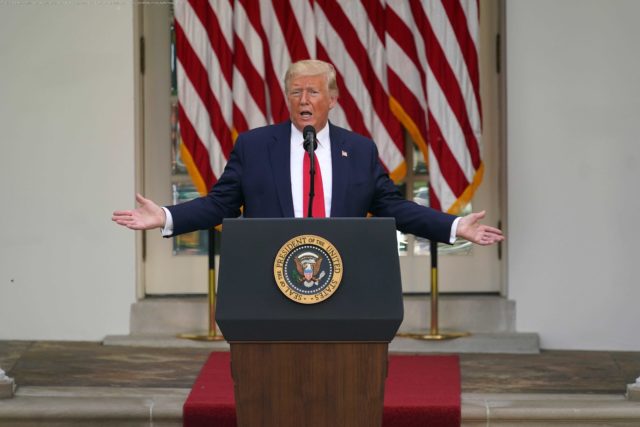President Donald Trump threatened Wednesday to close down social media platforms that “silence conservatives,” a day after Twitter for the first time added a fact…
President Donald Trump threatened Wednesday to close down social media platforms that “silence conservatives,” a day after Twitter for the first time added a fact check to one of his posts.
Trump posted two tweets alleging, without evidence, that expanded mail-in-voting could not be “anything less than substantially fraudulent” and would lead to a “Rigged Election.” Twitter added a warning label at the bottom of the tweets and link reading “Get the facts about mail-in ballots.” The link takes readers to a page with information on voting by mail and posts related to fact checks on Trump’s fraud claims.
Social media platforms’ handling of misleading posts have been under increasing scrutiny since the 2016 election, when the Russian government mounted a campaign to divide and misinform U. S. voters as part of its larger effort to influence the election. Officials and experts have warned Russia and other foreign actors are trying to do the same thing as the 2020 election nears.
Each company has responded to the problem in various ways.
Trump’s social media platform of choice has taken some of the most aggressive action to combat misinformation.
In February, the company announced it would begin labeling tweets that contain “synthetic and manipulated media.” In addition to labels and warnings, Twitter said it would reduce the visibility of tweets sharing altered photos or videos, and sometimes provide additional context and information. Tweets that shared media determined “likely to cause harm” would be subject to removal.
In response to the coronavirus pandemic, Twitter said March 16 it was broadening its definition of harm to include “content that goes directly against guidance from authoritative sources of global and local public health information.”
And on May 11, the company declared it was adding more labels and warnings to posts related to COVID-19 in order “to provide additional explanations or clarifications in situations where the risks of harm associated with a Tweet are less severe but where people may still be confused or misled by the content.”
Though Trump’s mail-in ballot tweets were not explicitly about the coronavirus, expanded vote-by-mail has been endorsed by Democratic and Republican governors who want to give their residents the opportunity to vote without risking the potential exposure to the virus that could come with in-person voting.
Home
United States
USA — mix Trump fuming at social media over Twitter fact check. How platforms handle...






